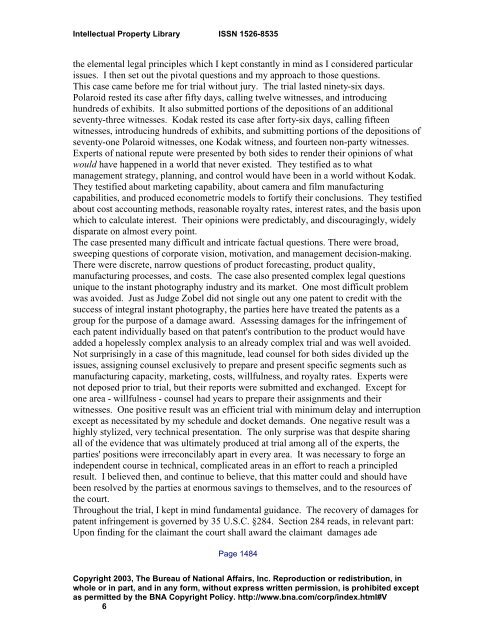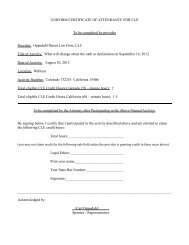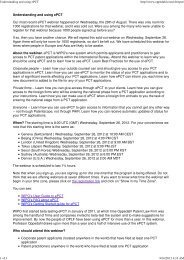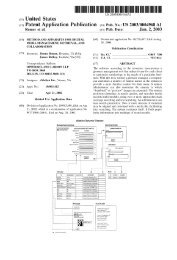Polaroid Corp. v. Eastman Kodak Co. - Oppedahl Patent Law Firm LLC
Polaroid Corp. v. Eastman Kodak Co. - Oppedahl Patent Law Firm LLC
Polaroid Corp. v. Eastman Kodak Co. - Oppedahl Patent Law Firm LLC
Create successful ePaper yourself
Turn your PDF publications into a flip-book with our unique Google optimized e-Paper software.
Intellectual Property Library ISSN 1526-8535<br />
the elemental legal principles which I kept constantly in mind as I considered particular<br />
issues. I then set out the pivotal questions and my approach to those questions.<br />
This case came before me for trial without jury. The trial lasted ninety-six days.<br />
<strong>Polaroid</strong> rested its case after fifty days, calling twelve witnesses, and introducing<br />
hundreds of exhibits. It also submitted portions of the depositions of an additional<br />
seventy-three witnesses. <strong>Kodak</strong> rested its case after forty-six days, calling fifteen<br />
witnesses, introducing hundreds of exhibits, and submitting portions of the depositions of<br />
seventy-one <strong>Polaroid</strong> witnesses, one <strong>Kodak</strong> witness, and fourteen non-party witnesses.<br />
Experts of national repute were presented by both sides to render their opinions of what<br />
would have happened in a world that never existed. They testified as to what<br />
management strategy, planning, and control would have been in a world without <strong>Kodak</strong>.<br />
They testified about marketing capability, about camera and film manufacturing<br />
capabilities, and produced econometric models to fortify their conclusions. They testified<br />
about cost accounting methods, reasonable royalty rates, interest rates, and the basis upon<br />
which to calculate interest. Their opinions were predictably, and discouragingly, widely<br />
disparate on almost every point.<br />
The case presented many difficult and intricate factual questions. There were broad,<br />
sweeping questions of corporate vision, motivation, and management decision-making.<br />
There were discrete, narrow questions of product forecasting, product quality,<br />
manufacturing processes, and costs. The case also presented complex legal questions<br />
unique to the instant photography industry and its market. One most difficult problem<br />
was avoided. Just as Judge Zobel did not single out any one patent to credit with the<br />
success of integral instant photography, the parties here have treated the patents as a<br />
group for the purpose of a damage award. Assessing damages for the infringement of<br />
each patent individually based on that patent's contribution to the product would have<br />
added a hopelessly complex analysis to an already complex trial and was well avoided.<br />
Not surprisingly in a case of this magnitude, lead counsel for both sides divided up the<br />
issues, assigning counsel exclusively to prepare and present specific segments such as<br />
manufacturing capacity, marketing, costs, willfulness, and royalty rates. Experts were<br />
not deposed prior to trial, but their reports were submitted and exchanged. Except for<br />
one area - willfulness - counsel had years to prepare their assignments and their<br />
witnesses. One positive result was an efficient trial with minimum delay and interruption<br />
except as necessitated by my schedule and docket demands. One negative result was a<br />
highly stylized, very technical presentation. The only surprise was that despite sharing<br />
all of the evidence that was ultimately produced at trial among all of the experts, the<br />
parties' positions were irreconcilably apart in every area. It was necessary to forge an<br />
independent course in technical, complicated areas in an effort to reach a principled<br />
result. I believed then, and continue to believe, that this matter could and should have<br />
been resolved by the parties at enormous savings to themselves, and to the resources of<br />
the court.<br />
Throughout the trial, I kept in mind fundamental guidance. The recovery of damages for<br />
patent infringement is governed by 35 U.S.C. §284. Section 284 reads, in relevant part:<br />
Upon finding for the claimant the court shall award the claimant damages ade<br />
Page 1484<br />
<strong>Co</strong>pyright 2003, The Bureau of National Affairs, Inc. Reproduction or redistribution, in<br />
whole or in part, and in any form, without express written permission, is prohibited except<br />
as permitted by the BNA <strong>Co</strong>pyright Policy. http://www.bna.com/corp/index.html#V<br />
6





